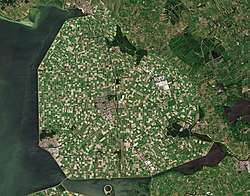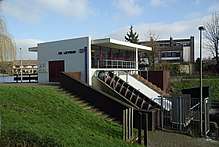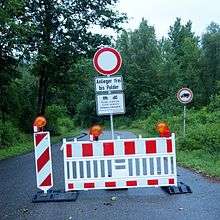Polder
A polder (Dutch pronunciation: [ˈpɔldər] (![]()
- Land reclaimed from a body of water, such as a lake or the seabed
- Flood plains separated from the sea or river by a dike
- Marshes separated from the surrounding water by a dike and subsequently drained; these are also known as koogs, especially in Germany

The ground level in drained marshes subsides over time. All polders will eventually be below the surrounding water level some or all of the time. Water enters the low-lying polder through infiltration and water pressure of groundwater, or rainfall, or transport of water by rivers and canals. This usually means that the polder has an excess of water, which is pumped out or drained by opening sluices at low tide. Care must be taken not to set the internal water level too low. Polder land made up of peat (former marshland) will sink in relation to its previous level, because of peat decomposing when exposed to oxygen from the air.
Polders are at risk from flooding at all times, and care must be taken to protect the surrounding dikes. Dikes are typically built with locally available materials, and each material has its own risks: sand is prone to collapse owing to saturation by water; dry peat is lighter than water and potentially unable to retain water in very dry seasons. Some animals dig tunnels in the barrier, allowing water to infiltrate the structure; the muskrat is known for this activity and hunted in certain European countries because of it. Polders are most commonly, though not exclusively, found in river deltas, former fenlands, and coastal areas.
Flooding of polders has also been used as a military tactic in the past. One example is the flooding of the polders along the Yser River during World War I. Opening the sluices at high tide and closing them at low tide turned the polders into an inaccessible swamp, which allowed the Allied armies to stop the German army.
Etymology
The Dutch word polder derives successively from Middle Dutch polre, from Old Dutch polra, and ultimately from pol-, a piece of land elevated above its surroundings, with the augmentative suffix -er and epenthetical -d-. The word has been adopted in thirty-six languages.[1]
Polders and the Netherlands

The Netherlands is frequently associated with polders, as its engineers became noted for developing techniques to drain wetlands and make them usable for agriculture and other development. This is illustrated by the saying "God created the world, but the Dutch created the Netherlands".[2]
The Dutch have a long history of reclamation of marshes and fenland, resulting in some 3,000 polders[3] nationwide. By 1961, about half of the country's land, 18,000 square kilometres (6,800 sq mi), was reclaimed from the sea.[4] About half the total surface area of polders in north-west Europe is in the Netherlands. The first embankments in Europe were constructed in Roman times. The first polders were constructed in the 11th century. The oldest stil existing polder is the Achtermeer polder, from 1533.
As a result of flooding disasters, water boards called waterschap (when situated more inland) or hoogheemraadschap (near the sea, mainly used in the Holland region)[5] [6] were set up to maintain the integrity of the water defences around polders, maintain the waterways inside a polder, and control the various water levels inside and outside the polder. Water boards hold separate elections, levy taxes, and function independently from other government bodies. Their function is basically unchanged even today. As such, they are the oldest democratic institutions in the country. The necessary cooperation among all ranks to maintain polder integrity gave its name to the Dutch version of third-way politics—the Polder Model.
The 1953 flood disaster prompted a new approach to the design of dikes and other water-retaining structures, based on an acceptable probability of overflowing. Risk is defined as the product of probability and consequences. The potential damage in lives, property, and rebuilding costs is compared with the potential cost of water defences. From these calculations follows an acceptable flood risk from the sea at one in 4,000–10,000 years, while it is one in 100–2,500 years for a river flood. The particular established policy guides the Dutch government to improve flood defences as new data on threat levels become available.
Major Dutch polders and the years they were laid dry include Beemster (1609–1612), Schermer (1633–1635), and Haarlemmermeerpolder (1852). Polders created as part of the Zuiderzee Works include Wieringermeerpolder (1930), Noordoostpolder (1942) and Flevopolder (1956–1968)
Examples of polders
Bangladesh
Bangladesh has 123 polders, of which 49 are sea-facing, while the rest are along the numerous distributaries of the Ganges-Brahmaputra-Meghna River delta. These were constructed in the 1960s to protect the coast from tidal flooding and reduce salinity incursion.[7] They reduce long-term flooding and waterlogging following storm surges from tropical cyclones. They are also cultivated for agriculture.[8]
Belgium
- De Moeren, near Veurne in West Flanders
- Polders along the Yser rive between Nieuwpoort and Diksmuide
- Polders of Muisbroek and Ettenhoven, in Ekeren and Hoevenen
- Polder of Stabroek, in Stabroek
- Kabeljauwpolder, in Zandvliet
- Scheldepolders on the left bank of the Scheldt
- Uitkerkse polders, near Blankenberge in West Flanders
- Prosperpolder, near Doel, Antwerp and Kieldrecht.
Canada
- Holland Marsh
- Pitt Polder Ecological Reserve
- Grand Pré, Nova Scotia
History
The Jiangnan region, at the Yangtze River Delta, has a long history of constructing polders. Most of these projects were performed between the 10th and 13th centuries.[10] The Chinese government also assisted local communities in constructing dikes for swampland water drainage.[11] The Lijia (里甲) self-monitoring system of 110 households under a lizhang (里长) headman was used for the purposes of service administration and tax collection in the polder, with a liangzhang (粮长, grain chief) responsible for maintaining the water system and a tangzhang (塘长, dike chief)for polder maintenance.[12]
Denmark
- Filsø
- Lammefjorden
Finland
- Söderfjärden
- Munsmo
- Two polders (three square kilometres or 1.2 square miles in total) near Vassor in Korsholm
France
- Marais Poitevin
- Les Moëres, adjacent to the Flemish polder De Moeren in Belgium.
Germany
In Germany, land reclaimed by dyking is called a koog. The German Deichgraf system was similar to the Dutch and is widely known from Theodor Storm's novella The Rider on the White Horse.
- Altes Land near Hamburg
- Blockland and Hollerland near Bremen
- Nordstrand, Germany
- Bormerkoog and Meggerkoog near Friedrichstadt
- 36 koogs in the district of Nordfriesland
- 12 koogs in the district of Dithmarschen

In southern Germany, the term polder is used for retention basins recreated by opening dikes during river floodplain restoration, a meaning somewhat opposite to that in coastal context.
Guyana
- Black Bush Polder, Corentyne, Berbice.
Ireland
- Lough Swilly, Co. Donegal. Near Inch Island and Newtowncunningham.[15]
Italy
- Delta of the river Po, such as Bonifica Valle del Mezzano
Lithuania
Netherlands
- Achtermeer, the oldest polder, from 1533
- Alblasserwaard, containing the windmills of Kinderdijk, a World Heritage Site
- Alkmaar
- Andijk
- Anna Paulownapolder
- Beemster, a World Heritage Site
- Bijlmermeer
- Flevopolder, the largest artificial island in the world, youngest polder, last part drained in 1968
- 's-Gravesloot
- Haarlemmermeer, containing Schiphol airport
- Krimpenerwaard
- Lauwersmeer
- Mastenbroek
- Noordoostpolder
- Prins Alexanderpolder
- Purmer
- Schermer
- Watergraafsmeer
- Wieringermeer
- Wieringerwaard
- Wijdewormer
- Zestienhoven, home of the Rotterdam The Hague Airport (Overschie), in the city of Rotterdam.
- Zuidplaspolder, along with Lammefjord in Denmark the lowest point of the European Union
Poland
- Vistula delta near Elbląg and Nowy Dwór Gdański
- Warta delta near Kostrzyn nad Odrą
Slovenia
South Korea
- Parts of the coast of Ganghwa Island, adjacent to the river Han in Incheon
- Delta of the river Nakdong in Busan
- Saemangeum in Jeollabuk-do
Spain
- Parts of Málaga were built on reclaimed land
United Kingdom
- Traeth Mawr
- Sunk Island, on the north shore of the Humber east of Hull
- Caldicot and Wentloog Levels along the Severn Estuary in South Wales
- Parts of The Fens
- Branston Island, by the River Witham outside the conventional area of the fens but connected to them.
- Parts of the coast of Essex
- Some land along the River Plym in Plymouth
- Some land around Meathop east of Grange-over-Sands, reclaimed as a side-effect of building a railway embankment
- The Somerset Levels and North Somerset Levels
- Romney Marsh
- Sealand, Flintshire
United States
- New Orleans
- Sacramento – San Joaquin River Delta
References
- Sijs, N. van der, 2010. Nederlandse woorden wereldwijd, 747 pp. Sdu Uitgevers bv, Den Haag. ISBN 9789012582148, https://pure.knaw.nl/portal/files/458170/Nww_compleet_archief.pdf, page 155
- Cf. Forrest Clingerman, Brian Treanor, Martin Drenthen, David Utsler, Interpreting Nature: The Emerging Field of Environmental Hermeneutics, Fordham University Press, 1 sep. 2013. The sentence stems from a poem by Archibald Pitcairn (1652–1713): Tellurem fecere dei, sua littora Belgae. C.D. van Strien, British Travellers in Holland During the Stuart Period: Edward Browne and John Locke as Tourists in the United Provinces, Leiden 1993, 164.
- "Kijk naar de geschiedenis". Rijkswaterstaat. Retrieved 2008-01-21.
- Ley, Willy (October 1961). "The Home-Made Land". For Your Information. Galaxy Science Fiction. pp. 92–106.
- "waterschap". Archived from the original on 2012-11-02.
- Reh, W., Steenbergen, C., Aten, D. 2007. Sea of Land, The polder as an experimental atlas of Dutch landscape architecture. 344 pp, Uitgeverij Architectura & Natura. ISBN 9789071123962
- "Bangladesh polders under threat", Irin News
- "Bangladeshi project to enhance polders amidst climate woes" Archived 2014-04-08 at the Wayback Machine, Unearth News
- "CRCWSC Trade Mission to Kunshan" (PDF). 2016-12-01.
- Liao, Qiyu 繆启愉 (1985). Taihu Tangpu Weitian Shi Yanjiu 太湖塘浦圩田史研究 [The research of the dikes and polders of Lake Tai]. Beijing: Nongye Chubanshe.
- Xie, Shi 谢湜 (2010). ""11 Shiji Taihu Diqu Nongtian Shuili Geju de Xingcheng" 11 世纪太湖地区农田水利格局的形成 [The formation of water management system in the farmland of the Lake Tai region in the eleventh century]". Journal of Sun Yat-sen University. 50 (5): 94–106.
- Hamashima, Atsutoshi 滨岛敦俊 (1982). Mindai Kōnan nōson shakai no kenkyū 明代江南農村社会の研究 [Rural Society in Jiangnan during the Ming Dynasty. Tokyo: Tokyo University Press. pp. 9–65.
- "Rain continues to throw a challenge in Kuttanad". The Hindu. The Hindu Group. 2011. Retrieved 2011-06-10.
- Thampatti, Manorama (March 1999). "Rice Bowl in Turmoil: The Kuttanad Wetland Ecosystem". Resonance. Indian Academy of Sciences. Archived from the original on 2010-12-16. Retrieved 2011-06-10.
- "Inch Wildfowl Reserve History". Inch and Foyle Wildfowl Project. Archived from the original on 7 September 2015. Retrieved 5 June 2015.
Further reading
- Derex, Jean-Michel, Franco Cazzola (eds.) 2004. 2nd ed. 2013. Eau et développement dans l'Europe moderne. Paris, Maison des Sciences De L'Homme
- Farjon, J.M.J., J. Dirkx, A. Koomen, J. Vervloet & W. Lammers. 2001. Neder-landschap Internationaal: bouwstenen voor een selectie van gebieden landschapsbehoud. Alterra, Wageningen. Rapport 358.
- Stenak, Morten. 2005. De inddæmmede Landskaber – En historisk geografi. Landbohistorik Selskab.
- Polders of the World. Keynotes International Symposium. 1982. Lelystad, The Netherlands
- Ven, G.P. van de (ed.) 1993, 4th ed. 2004. Man-made Lowlands. History of Water Management and Land Reclamation in the Netherlands, Matrijs, Utrecht.
- Wagret, Paul. 1972. Polderlands. London: Methuen.
External links
| Wikimedia Commons has media related to Polders. |
- Polder landscapes in the Netherlands — in a northwest European and a landmark context.
- How to make a polder — online film